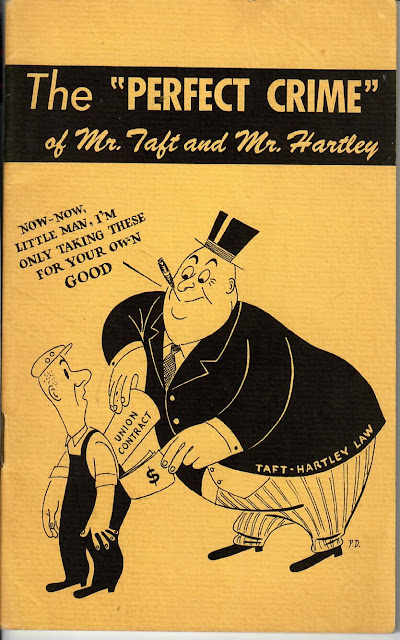"WAYS TO FIGHT BACK
One way is not to use the law, and many CIO unions have already decided to take this course. The Steelworkers, the United Electrical Workers, the Auto Workers, the Longshoremen and Warehousemen and many other international unions of the CIO have stated they will have no part of the new National Labor Relations Board.
You will see when you read this booklet they have good reason.
The Board is no longer the guardian of workers rights, but a tool in the hands of the employers. Labor's Bill of Rights, the Wagner Act, has been replaced.
A new 'Bill of Rights for Employers' has been put in its place.
Another way is to ignore the law, and this the CIO intends to do in certain instances. There are higher and better laws than the one dreamed up by Mr. Taft and Mr. Hartley and one of them is the Constitution of the United States.
Where laws conflict - and some of the provisions of the Taft-Hartley law certainly conflict with the Constitution - we will choose to observe the Constitution.
Still another way is to build your union and rely on the determination and loyalty of your members to keep it strong. This is the way to win when the chips are down."
Issued by the California CIO Council in July, 1947.
The Taft-Hartley law, passed in 1947, decimated gains American unions had made in the 14 years prior since the passage of the National Industrial Recovery Act. It has explicit language in regards to secondary boycotts and put extreme limitations on labors ability to picket and strike. It has provisions forbidding communists and radicals being elected to union leadership and gives the U.S. President executive power to get court injunctions against strikers and use the armed forces to this effect.
For the duration of WW2 almost all unions voluntarily signed no strike pledges, even communist led radical unions who knew their unions had to survive the war patriotism and political climate of the time. An unprecedented strike wave swept the nation at the conclusion of the war. Workers had voluntarily stomached wage freezes and production speed ups for years. Taft-Hartley was in direct response to American workers shutting down most major industries in the country.
Taft-Hartley is still in effect today and the National Labor Relations Board should be viewed as a small box that American workers have been forced to sit in.
REPEAL TAFT-HARTLEY

Comments
Post a Comment